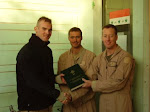
In the public life of Jesus Mary appears prominently; at the very beginning when at the marriage feast of Cana, moved with pity, she brought about by her intercession the beginning of the miracles of Jesus the Messiah (cf. John 2: 1-11). In the course of her Son's preaching she received the words whereby, in extolling a kingdom beyond the concerns and ties of flesh and blood, he declared blessed those who heard and kept the word of God (cf. Mk 3:35; Lk 11:27-28) as she was faithfully doing (cf. Lk 2:19; 51). Thus the Blessed Virgin advanced in her pilgrimage of faith, and faithfully preserved in her union with her Son unto the cross, where she stood (cf. Jn 19:25), in line with the divine plan, enduring with her only begotten Son the intensity of his passion, with his sacrifice, associating herself in her mother's heart, and lovingly consenting to the immolation of this victim which was born of her. Finally, she was given by the same Christ Jesus dying on the cross as a mother to his disciple, with these words: 'Woman, behold thy son' (Jn 19: 26-27)" (Second Vatican Council, Lumen gentium, 58).
Why are Mary's prayers so effective with God? The prayers of the saints are prayers of servants, whereas Mary's are a Mother's prayer, whence flows their efficacy and their authority; and since Jesus has immense love for his Mother, she cannot pray without being listened to...To understand Mary's great goodness, let us remember what the Gospel says...There was a shortage of wine, which naturally worried the married couple. No one asks the Blessed Virgin to intervene and request her Son to come to the rescue of the couple...; it stirs her to act as intercessor and ask her Son for the miracle, even though no one asks her to...If our Lady acted like this without being asked, what would she not have done if they actually asked her to intervene?" (St. Alphonsus Mary Ligouri, Sunday Sermons, 48).
Meeting Christ in the Liturgy offers a reflection for the Second Sunday after Epiphany.
(Art: Veronese, Paolo, Wedding Feast at Cana, 2nd third of 16th century, Musée du Louvre.)










